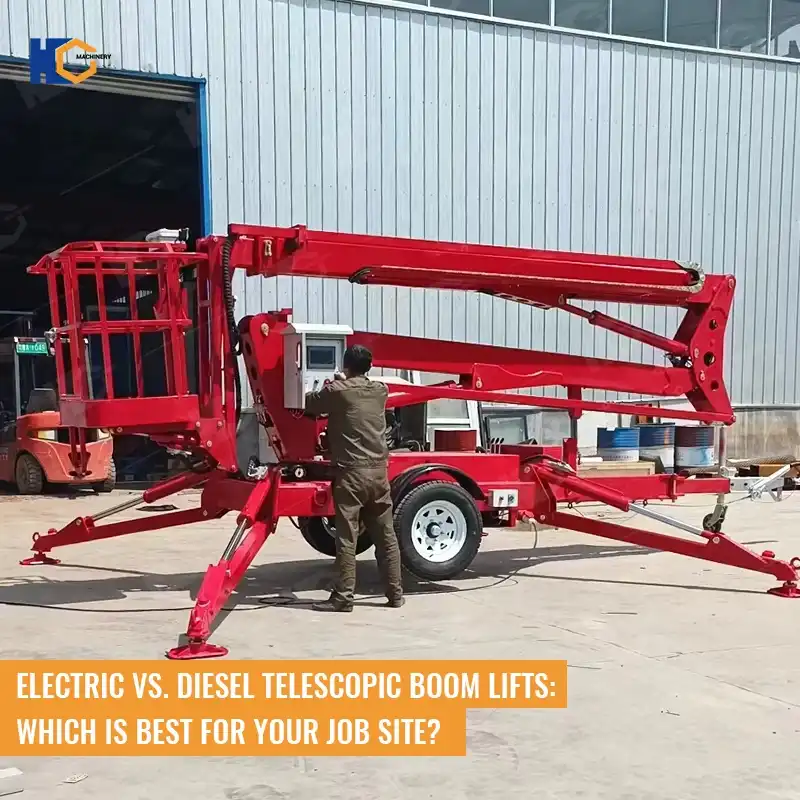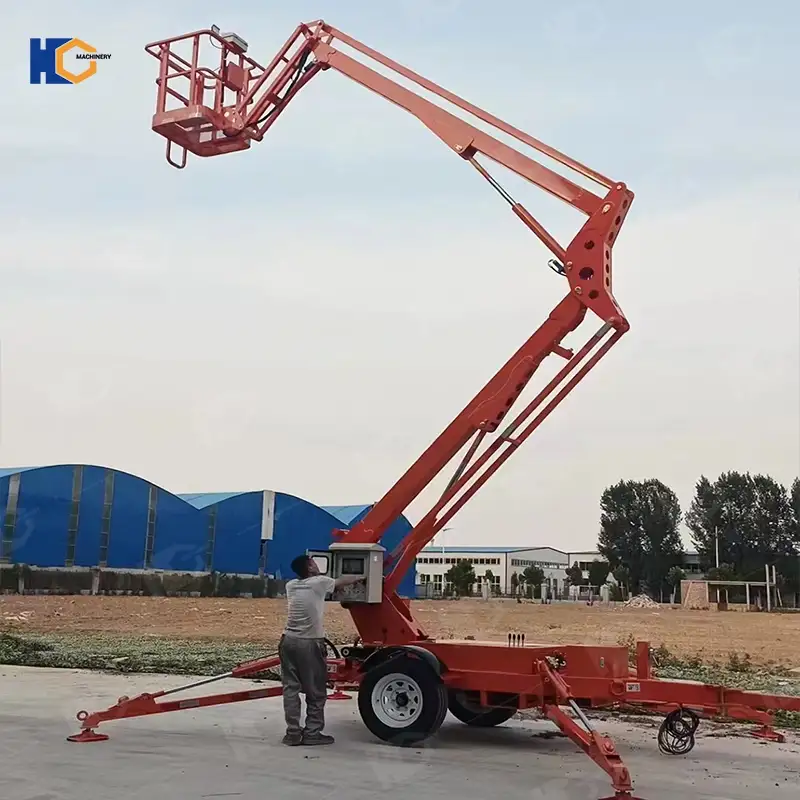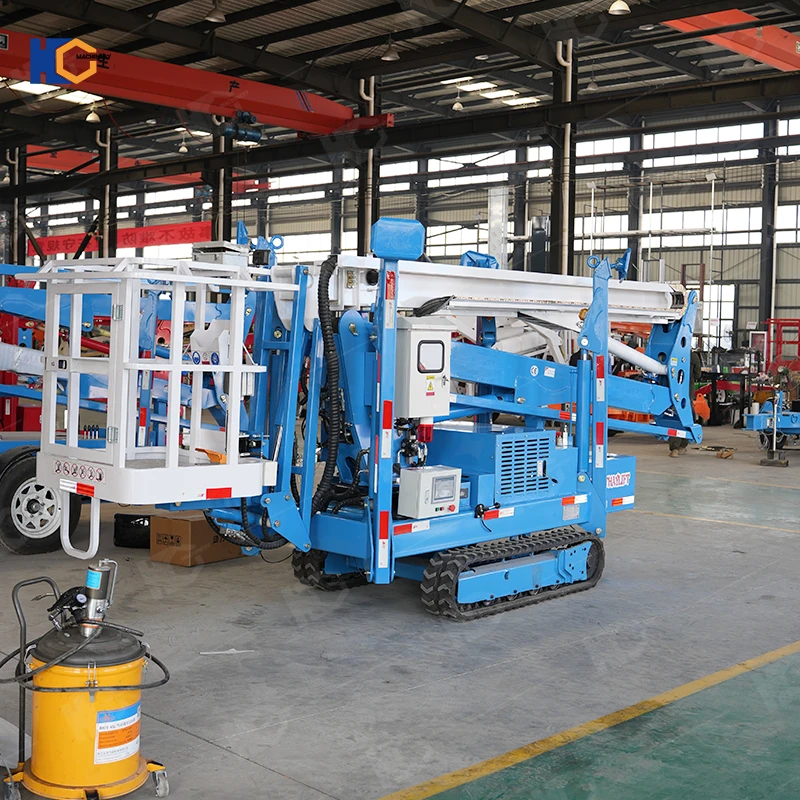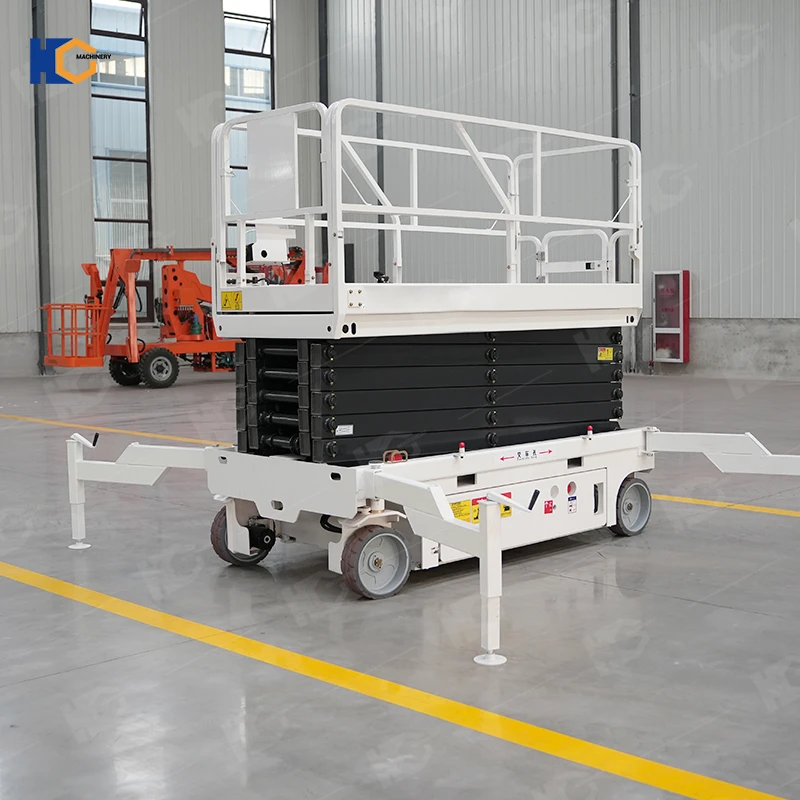Telescopic boom lifts are essential aerial work platforms that provide vertical reach and stability for construction, maintenance, and industrial applications. With their straight, extendable arms, these machines offer superior height capabilities compared to articulating booms, making them ideal for tasks like building facades, bridge work, and high-reach installations.
Choosing between electric and diesel power sources is a critical decision that impacts job site efficiency, operational costs, and environmental compliance. Electric models run on rechargeable batteries, producing zero emissions and minimal noise—perfect for indoor projects or urban areas with strict pollution regulations. Diesel-powered lifts, on the other hand, deliver robust performance in outdoor, rugged environments where extended runtime and higher load capacities are required.
When selecting the right telescopic boom lift, key factors include:
Environment (indoor/outdoor use, emissions restrictions)
Cost (fuel expenses, maintenance, and long-term ownership)
Performance (power output, reach, and terrain adaptability)
Maintenance (complexity, downtime, and service requirements)
Understanding these differences ensures optimal productivity, safety, and cost-effectiveness for your specific job site needs. Whether you prioritize eco-friendliness or heavy-duty performance, this guide will help you make an informed choice between electric and diesel telescopic boom lifts.
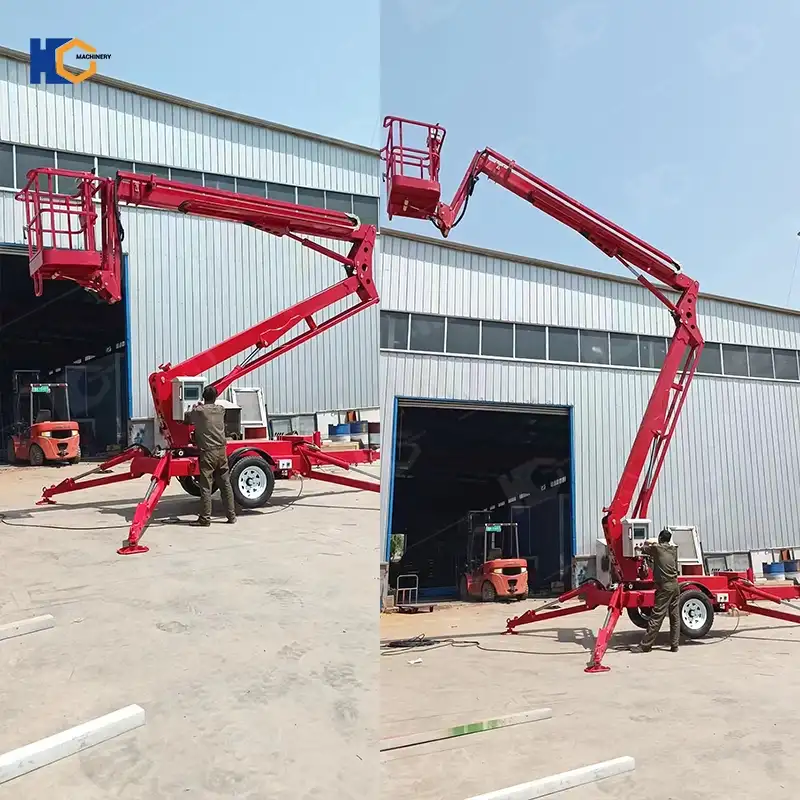
Electric Telescopic Boom Lifts: Pros, Cons, and Best Applications
Advantages of Electric Telescopic Boom Lifts
1. Zero Emissions – Ideal for Indoor and Urban Use
Electric telescopic boom lifts operate on battery power, producing no exhaust emissions, making them perfect for:
Indoor construction (warehouses, hospitals, shopping malls)
Urban job sites with strict air quality regulations
Confined spaces where diesel fumes would be hazardous
Unlike diesel models, electric lifts comply with EPA and OSHA indoor air quality standards, eliminating the need for costly ventilation systems.
2. Quieter Operation – Reduced Noise Pollution
With noise levels typically below 75 decibels, electric boom lifts are significantly quieter than diesel-powered alternatives. This makes them ideal for:
Hospitals and schools (minimizing disruptions)
Residential areas with noise restrictions
Night shifts where loud machinery would violate local ordinances
3. Lower Fuel Costs – No Diesel Expenses
Electric models eliminate fuel costs, relying instead on rechargeable lithium-ion or lead-acid batteries. Benefits include:
Lower operating expenses (electricity is cheaper than diesel)
No fuel storage or spill risks
Reduced dependency on fluctuating fuel prices
4. Easier Maintenance – Fewer Moving Parts
Electric boom lifts have simpler drivetrains compared to diesel engines, resulting in:
Fewer breakdowns (no fuel injectors, exhaust systems, or complex transmissions)
Reduced servicing needs (no oil changes or diesel particulate filter maintenance)
Longer lifespan with proper battery care
Disadvantages of Electric Telescopic Boom Lifts
1. Limited Runtime – Battery Life Constraints
While diesel lifts can refuel in minutes, electric models require hours to recharge, leading to:
Downtime during long shifts
Battery degradation over time, reducing efficiency
Need for backup batteries on extended projects
2. Slower Charging vs. Refueling
Standard charging can take 8–10 hours for a full cycle
Fast-charging options may reduce lifespan
Battery swaps require additional equipment and labor
3. Lower Power in Extreme Conditions
Electric lifts may struggle with:
Heavy loads at maximum height (reduced efficiency under strain)
Cold weather performance (batteries drain faster in low temperatures)
Rugged terrain (unless equipped with high-torque motors)
Best Use Cases for Electric Telescopic Boom Lifts
1. Indoor Construction (Warehouses, Hospitals, Factories)
No fumes or noise disturbances
Ideal for HVAC installations, lighting repairs, and ceiling work
2. Urban Projects with Strict Emissions Regulations
Compliance with city air quality laws (e.g., London’s ULEZ, California’s CARB)
Preferred for facade cleaning, window installations, and signage work
3. Shorter-Duration Tasks with Charging Access
Best for 8-hour shifts with scheduled charging breaks
Suitable for event setups, film production, and maintenance work
Electric telescopic boom lifts offer clean, quiet, and cost-efficient operation, making them ideal for indoor, urban, and environmentally sensitive job sites. However, their limited runtime and reduced power in extreme conditions may require careful planning.
Choose electric if:
✔ You work indoors or in noise-sensitive areas
✔ Your projects require short to medium shifts
✔ You prioritize low emissions and fuel savings
For heavy-duty outdoor applications, a diesel telescopic boom lift may be more suitable.
Diesel Telescopic Boom Lifts: Advantages, Limitations, and Ideal Applications
Key Advantages of Diesel Telescopic Boom Lifts
1. Superior Power & Extended Runtime for Heavy-Duty Work
Diesel-powered telescopic boom lifts deliver:
Greater torque and lifting capacity – Ideal for handling heavy materials at maximum heights
Continuous operation – No battery limitations; work shifts can last as long as fuel is available
Better performance in demanding conditions – Maintains power even with full loads at extreme reaches
2. Rapid Refueling Minimizes Downtime
Unlike electric models that require hours to recharge:
Refueling takes just minutes, keeping projects moving
No battery swaps or charging stations needed – Critical for fast-paced job sites
Ideal for 24/7 operations – Simply refill the tank and continue working
3. Enhanced Performance on Rough Terrain
Diesel boom lifts excel in challenging environments due to:
Heavy-duty chassis and reinforced components – Withstands uneven ground and off-road conditions
All-terrain tires and 4WD options – Provides stability on construction sites, oil fields, and rural areas
Higher ground clearance – Navigates obstacles better than electric models
Disadvantages of Diesel Telescopic Boom Lifts
1. Noise & Emissions Make Them Unsuitable for Indoor Use
Loud engine noise (85+ decibels) – Can violate noise ordinances in urban areas
Exhaust fumes – Prohibited in enclosed spaces due to health and safety risks
Not compliant with green building standards – Many cities restrict diesel equipment in emission-controlled zones
2. Higher Operating & Maintenance Costs
Diesel fuel expenses – More volatile pricing compared to electricity
Frequent maintenance needs – Requires oil changes, filter replacements, and emission system servicing
More complex engine repairs – Diesel components are costlier to fix than electric systems
3. Stricter Environmental Regulations
Modern diesel lifts must meet:
EPA Tier 4 Final standards – Mandates advanced emission controls (DPF, SCR systems)
Local air quality laws – Some regions ban older diesel models entirely
Higher compliance costs – AdBlue (DEF) fluid and particulate filter maintenance add operational complexity
Best Use Cases for Diesel Telescopic Boom Lifts
1. Outdoor Construction in Rugged Terrain
Bridge and highway projects – Handles uneven ground and long-duration tasks
Industrial plant maintenance – Reaches high structures without power constraints
Oil & gas refineries – Performs reliably in remote, harsh environments
2. Remote Job Sites Without Electrical Infrastructure
Mining and forestry operations – No need for charging stations
Rural infrastructure projects – Works where grid power is unavailable
Disaster recovery zones – Operates independently of local utilities
3. Long-Duration Projects Requiring Non-Stop Operation
Large-scale commercial construction – No battery limits for all-day shifts
Airport and shipyard maintenance – Continuous uptime for critical repairs
Military and defense applications – Reliable performance in field conditions
Diesel telescopic boom lifts provide unmatched power, endurance, and off-road capability, making them indispensable for heavy-duty outdoor projects. However, their noise, emissions, and higher operating costs limit their use in urban and indoor settings.
Choose a diesel model if:
✔ Your job site is outdoors, remote, or rugged
✔ You need 24/7 operation with quick refueling
✔ The project requires heavy lifting at extreme heights
For indoor, urban, or emission-sensitive work, an electric telescopic boom lift may be more suitable.
Key Comparison Factors
| Factor | Electric | Diesel |
|---|---|---|
| Environment | Clean, indoor-friendly | Loud, outdoor-only |
| Cost | Lower fuel, higher upfront | Higher fuel, lower upfront |
| Performance | Moderate power, limited runtime | High power, long runtime |
| Maintenance | Simpler, fewer parts | More complex, frequent servicing |
How to Choose Between Electric and Diesel Telescopic Boom Lifts
Selecting the right telescopic boom lift—electric or diesel—depends on your specific job site requirements. Here are the key factors to consider:
1. Indoor vs. Outdoor Needs (Emissions & Noise)
Electric boom lifts are ideal for:
Indoor projects (warehouses, hospitals, retail spaces)
Urban areas with strict noise and emission regulations
Sensitive environments (hospitals, schools, residential zones)
Diesel boom lifts are better for:
Outdoor construction (highways, bridges, oil fields)
Remote job sites without power access
Noise-tolerant areas where engine sound isn’t restricted
2. Project Duration & Power Access (Battery Life vs. Refueling)
Electric lifts require:
Battery charging (8+ hours) – Best for single shifts with scheduled breaks
Access to charging stations – Not practical for remote locations
Diesel lifts offer:
Unlimited runtime – Refuel in minutes and continue working
24/7 operation – No downtime for recharging
3. Budget Considerations (Upfront Cost vs. Long-Term Savings)
| Factor | Electric | Diesel |
|---|---|---|
| Initial Cost | Higher (battery tech) | Lower |
| Fuel Costs | Cheaper (electricity) | Expensive (diesel) |
| Maintenance | Lower (fewer parts) | Higher (engine upkeep) |
| Lifespan | Battery replacement needed | Longer engine life |
4. Terrain & Load Requirements (Rough Terrain Favors Diesel)
Electric lifts work best on:
Smooth, flat surfaces (concrete floors, paved areas)
Light to medium loads (up to 500–1,000 lbs at full extension)
Diesel lifts excel in:
Uneven or rugged terrain (dirt, gravel, slopes)
Heavy-duty lifting (1,000+ lbs at max height)
Final Decision Checklist
✔ Indoor/urban work? → Electric
✔ Long shifts, remote sites? → Diesel
✔ Budget-focused? → Compare fuel vs. maintenance costs
✔ Heavy loads, rough ground? → Diesel
By evaluating these factors, you can choose the most efficient, cost-effective, and compliant telescopic boom lift for your project.
Conclusion: Selecting the Right Telescopic Boom Lift
When choosing between electric and diesel telescopic boom lifts, the decision ultimately comes down to your job site conditions, operational needs, and budget.
Electric lifts excel in indoor, urban, and emission-sensitive environments, offering quiet operation and lower long-term costs—but with limited runtime.
Diesel lifts dominate in outdoor, rugged, and remote applications, providing greater power, endurance, and faster refueling—at the expense of higher noise and emissions.
To ensure the best fit:
✔ Match the lift to your work environment (indoor/outdoor, terrain, regulations).
✔ Consider project duration and power availability (battery life vs. refueling needs).
✔ Weigh upfront costs against long-term savings (maintenance, fuel, and efficiency).
For personalized recommendations, consult with equipment suppliers who can assess your specific requirements. The right choice will maximize productivity, safety, and cost-efficiency on your job site.
JNHC LIFT – Your Trusted Telescopic Boom Lift Manufacturer in China
As a leading telescopic boom lift manufacturer in China, JNHC LIFT provides high-quality, reliable aerial work platforms for global clients. Our boom lifts are engineered for superior performance, durability, and safety, making them ideal for construction, maintenance, and industrial applications.
We offer:
✔ Customized solutions for different job site requirements
✔ Competitive pricing without compromising quality
✔ Strict quality control meeting international standards
Contact us to discuss your needs—whether you require electric, diesel, or hybrid telescopic boom lifts. Partner with JNHC LIFT for efficient, cost-effective lifting solutions delivered worldwide!
